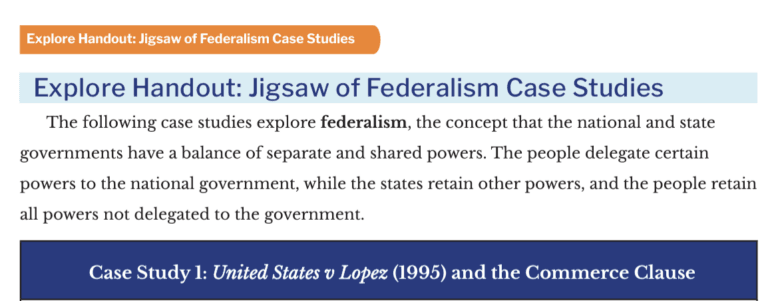Jigsaw of Federalism Case Studies
A handout to accompany the Federalism Case studies that guide students in their understanding of them.
Explore Handout: Jigsaw of Federalism Case Studies
The following case studies explore federalism, the concept that the national and state governments have a balance of separate and shared powers. The people delegate certain powers to the national government, while the states retain other powers, and the people retain all powers not delegated to the government.
| Case Study 1: United States v Lopez (1995) and the Commerce Clause
|
| 1. Shrink the text: Summarize the main idea of this case study in one sentence.
2. Explain the connection of United States v. Lopez (1995) to federalism.
3. If Congress cannot regulate guns on school grounds because it does not have a significant impact on interstate commerce, is there a better constitutional argument for Congress to claim this power? Why?
|
| Case Study 2: The Nullification Crisis |
| 1. Shrink the text: Summarize the main idea of this case study in one sentence.
2. Explain the connection of the Nullification Crisis to federalism.
3. How did President Andrew Jackson argue against Vice President John C. Calhoun’s theory of nullification? Which argument had a stronger constitutional basis? Why?
|
| Case Study 3: McCulloch v. Maryland (1819) and the Necessary and Proper Clause |
| 1. Shrink the text: Summarize the main idea of this case study in one sentence.
2. Explain the connection of McCulloch vs. Maryland (1819) to federalism.
3. Should states be constitutionally allowed to tax the national government? Explain your answer.
|
Assess and Reflect:
- Did any of the case studies surprise you? Explain.
- If you had to explain federalism to someone unfamiliar with the U.S. government, what would you say?
- What do these case studies reveal about the dynamic interplay between states and the national government?
- How do you see the effects of federalism in your own life? Explain.
